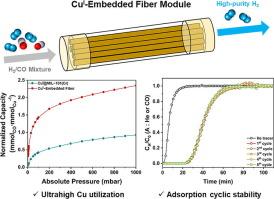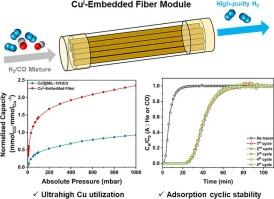cui包埋纤维CO选择性吸附吸附剂用于高纯度H2回收
IF 13.2
1区 工程技术
Q1 ENGINEERING, CHEMICAL
引用次数: 0
摘要
一氧化碳(CO)去除技术在氢(H2)净化的背景下至关重要,以实现经济上可行的氢价值链。在此,我们开发了一种新型的结构吸附剂,即将Cu源掺入MOF/聚合物复合纤维中制备的Cu -embedded fiber吸附剂,用于选择性去除富h2气体中的CO。在静态和/或动态吸附条件下,cu包埋纤维的动态吸附性能比纯MIL-101(Cr)/PVDF纤维的动态吸附能力高1.4 ~ 2.6倍。我们还证实了载体的形状因素会影响注入铜种的聚集效果。值得注意的是,与粉末形式的吸附剂相比,纤维形式的吸附剂表现出更强的铜分散能力,从而获得了超高的铜利用率。通过原位CO漫反射红外傅里叶变换光谱(DRIFTS)分析鉴定出新的CuI活性位点,进一步阐明了Cu含量的高度分散,表明活性金属位点的形成具有不同的微环境。这项工作突出了基于吸附的一氧化碳去除系统的新概念,具有高纯度H2回收的潜在应用。本文章由计算机程序翻译,如有差异,请以英文原文为准。


CuI-Embedded fiber sorbent with CO selective adsorption for High-Purity H2 recovery
Carbon monoxide (CO) removal techniques are critically important in the context of hydrogen (H2) purification to achieve an economically viable hydrogen value chain. Herein, we develop the new type of structured sorbents, CuI-embedded fiber sorbents, fabricated by incorporating Cu sources into MOF/polymer composite fibers, for selective removal of CO from H2-rich gas. CuI-embedded fiber sorbents show remarkable dynamic adsorption performance, 1.4 – 2.6 times greater dynamic sorption capacities than those of pure MIL-101(Cr)/PVDF fiber, across the range of CO compositions and cyclic stability under the static and/or dynamic adsorption conditions. We also confirm that the form-factor of support can influence to the aggregation effect of infused copper species. Notably, compared to the powder form sorbents, these fiber-form sorbents show enhanced copper dispersion ability, resulting in the ultrahigh Cu utilization degree. The new CuI active sites, identified from the in-situ CO diffuse reflectance infrared Fourier transform spectroscopy (DRIFTS) analysis, further elucidate the highly dispersed Cu contents, implying that the formation of active metal sites with different micro-environments. This work highlights the new concepts of the adsorption-based carbon monoxide removal system with potential application for high-purity H2 recovery.
求助全文
通过发布文献求助,成功后即可免费获取论文全文。
去求助
来源期刊

Chemical Engineering Journal
工程技术-工程:化工
CiteScore
21.70
自引率
9.30%
发文量
6781
审稿时长
2.4 months
期刊介绍:
The Chemical Engineering Journal is an international research journal that invites contributions of original and novel fundamental research. It aims to provide an international platform for presenting original fundamental research, interpretative reviews, and discussions on new developments in chemical engineering. The journal welcomes papers that describe novel theory and its practical application, as well as those that demonstrate the transfer of techniques from other disciplines. It also welcomes reports on carefully conducted experimental work that is soundly interpreted. The main focus of the journal is on original and rigorous research results that have broad significance. The Catalysis section within the Chemical Engineering Journal focuses specifically on Experimental and Theoretical studies in the fields of heterogeneous catalysis, molecular catalysis, and biocatalysis. These studies have industrial impact on various sectors such as chemicals, energy, materials, foods, healthcare, and environmental protection.
 求助内容:
求助内容: 应助结果提醒方式:
应助结果提醒方式:


